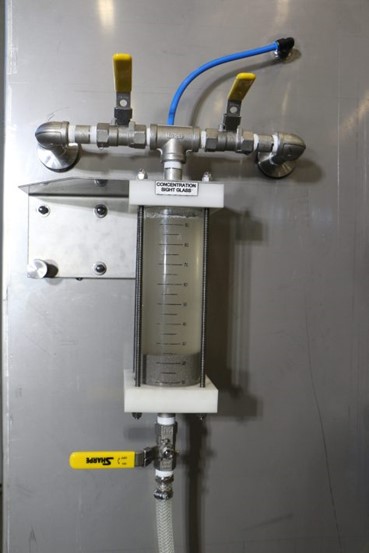
Wet Blasting Equipment & Media, Part 3 – Maintain Slurry Concentration for Finishing Consistency
, sramaker - Zurück zur Übersicht
Wet blasting propels a mixture of media and process water at the surface of a work piece to provide cosmetic (anti-glare) finishes, surface smoothing, deburring, de-powdering, decontaminating, and cleaning after casting, welding, machining, and additive manufacturing.
Useful in a variety of industries, this specialized form of shot blasting relies heavily on the media and water mix known as wet blasting slurry to work in tandem with the machinery in order to deliver the desired finishing results.
Rosler has extensive experience developing wet blasting systems as well as providing guidance on slurry concentrations and supplying the necessary consumables.
Slurry Characteristics
Wet blast schematic
The slurry is created in a tank housed within the blast chamber by mixing water and an abrasive media. A special pump delivers the slurry to the blast gun where it is then propelled onto the work surface using compressed air.
High-speed impact of the slurry on the surface of the work piece creates the desired blasting effect, be it cleaning, coating preparation, cosmetic surface texturing, or peening.
Wet blasting in process
The concentration of abrasive media in the slurry usually amounts to 10-40% by volume, for example, 20% media and 80% water, etc.
Establishing the ideal concentration may require extensive processing trials initially or if the work pieces and their original condition change. In these cases, contact the machine manufacturer for guidance.
Controlling Slurry Concentrations
Regular and gradual slurry loss is expected even in a well-calibrated finishing operation. During the blast process the media wears by becoming smaller or fracturing. These smaller and irregular pieces must be removed from the system.
To make up for this loss and removal of undersized media, new media must be added. Maintaining a very tight tolerance range of 1-2% in the prescribed slurry concentration is required to achieve consistent results.
For smaller systems, maintaining slurry concentration can be done by visual inspection of the media-to-water ratio in the graduated viewing glass of the concentration measurement unit and manually adding media as needed. In larger blast systems, the slurry concentration is controlled automatically with an ultrasonic level sensor, a weighing system, or continuous density measurement.
Adding media to the desired concentration level can be done manually or through an automated, PLC-controlled media adder.
Manual slurry concentration measurement unit
The Rosler Way
Rosler has more than 80 years of experience in shot blasting. Whatever your wet blasting challenges are, we are confident that we can deliver a solution. Contact us to discuss your needs today!
Previous posts in the Wet Blasting Equipment & Media series include:
- Part 1 – “Machines Range in Complexity, Uses.”
- Part 2 – “Technical Components Combine for Systematic Success.”
Upcoming posts will include:
- Part 4 – “Internal Cleaning, Rebuilds Prolong Machine Lifetime.”
- Part 5 – “Careful Media Selection, Additive Use Impact Results.”
Sign up for enews alerts to be notified of new posts!

